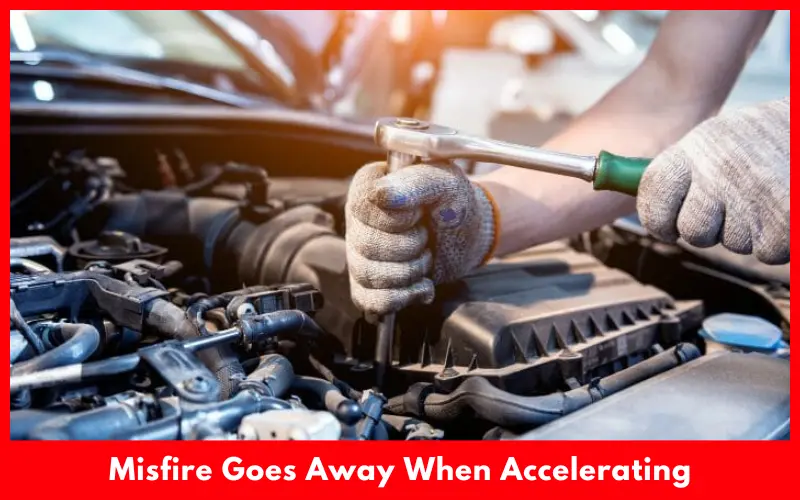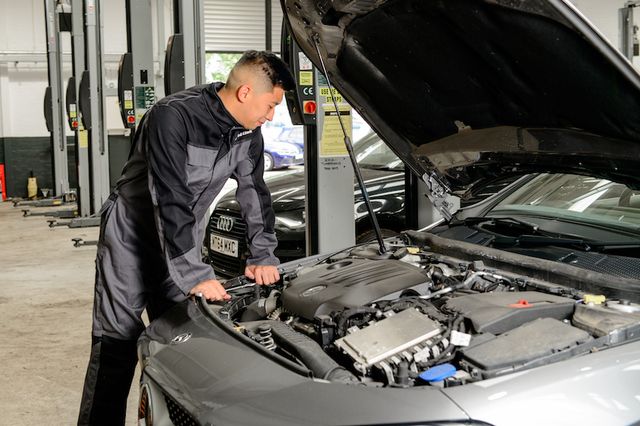


A misfire is an abnormal combustion event or a complete lack of combustion in one or more cylinders of an internal combustion engine. It can cause rough idling, power loss, and increased emissions. When a misfire occurs only at low RPMs or during idling but goes away when accelerating, it indicates a specific set of underlying issues. Understanding the causes and troubleshooting methods for this type of misfire is crucial for proper diagnosis and repair.

Before we dive into the nitty-gritty details, let's first explore the main culprits behind this misbehavior. The most common causes for an engine misfire that goes away when accelerating can be categorized into four main groups:
| Ignition System Issues | Fuel System Problems | Vacuum Leaks | Mechanical Issues |
|---|---|---|---|
| - Worn-out or faulty spark plugs - Faulty ignition coil or coil pack - Damaged spark plug wires | - Clogged or dirty fuel injectors - Low fuel pressure | - Intake manifold or vacuum hose leaks | - Low compression |
The ignition system plays a crucial role in providing the spark that ignites the air-fuel mixture within the engine's cylinders. If any component of this system falters, it can lead to misfires, especially at lower RPMs.
Worn-out or Faulty Spark Plugs: These little guys are responsible for delivering the spark that sets the combustion process in motion. Over time, they can become fouled, worn, or damaged, causing them to struggle at idle or low RPMs. However, when you accelerate, the increased voltage supplied to the spark plugs can temporarily compensate for their weakened state, allowing them to fire properly.
Faulty Ignition Coil or Coil Pack: The ignition coil is the heart of the ignition system, providing the high voltage necessary for the spark plugs to do their job. If this component is failing, it may not have enough oomph at idle, but the increased demand during acceleration can temporarily mask the issue.
Damaged Spark Plug Wires: These wires act as conduits, carrying the high voltage from the ignition coil to the spark plugs. If they're old, cracked, or damaged, they can cause misfires at lower RPMs, but the higher voltages during acceleration may allow them to function adequately, at least for a while.
The fuel system is responsible for delivering the precise amount of fuel to each cylinder, ensuring a proper air-fuel mixture for combustion. Any disruption in this delicate balance can lead to misfires, especially at idle or low RPMs.

Clogged or Dirty Fuel Injectors: Fuel injectors are tasked with atomizing and delivering the fuel into the engine's cylinders. Over time, they can become clogged or dirty, restricting fuel flow at idle or low RPMs. However, when you accelerate, the increased fuel pressure can temporarily force more fuel through the clogged injectors, alleviating the misfire.
Low Fuel Pressure: If the fuel pump is weakening or there are restrictions in the fuel lines, fuel pressure may drop at idle, leading to a lean misfire. But when you accelerate, the increased demand for fuel can temporarily boost the pressure, resolving the misfire.
Vacuum leaks are often overlooked but can wreak havoc on an engine's performance. These leaks allow unmetered air to enter the engine, disrupting the carefully calculated air-fuel ratio.
Intake Manifold or Vacuum Hose Leaks: Cracks or holes in the intake manifold or vacuum hoses can cause a lean misfire at idle by allowing extra air to sneak in. However, when you accelerate, the increased manifold pressure can temporarily seal off these leaks, restoring the proper air-fuel mixture and eliminating the misfire.
Sometimes, the root cause of a misfire that goes away when accelerating can be traced back to mechanical issues within the engine itself.
Low Compression: If an engine has low compression in one or more cylinders due to worn piston rings, valve issues, or other mechanical problems, it may struggle to ignite the air-fuel mixture at idle or low RPMs, causing a misfire. However, the higher cylinder pressures generated during acceleration can temporarily mask this issue, allowing the engine to run smoothly, at least until you let off the gas.
Now that we've explored the potential causes, let's dive into the diagnostic process. As a mechanic, I follow a systematic approach to pinpoint the root cause of a misfire that goes away when accelerating.
Check for Trouble Codes
Cylinder Drop Test
Fuel Trim Analysis
Cylinder Leak Down Test
Visual Inspections
Check for Trouble Codes: The first step is to connect a diagnostic scanner to the vehicle's computer and check for any trouble codes related to misfires, ignition system issues, fuel system problems, or vacuum leaks. These codes can provide valuable clues about the system causing the misfire.
Cylinder Drop Test: With the engine running, I'll pull the coil wire off one cylinder at a time. If that cylinder was misfiring, the engine sound won't change much, indicating an ignition issue for that specific cylinder.
Fuel Trim Analysis: By monitoring the fuel trims on a scan tool, I can gain insights into the fuel delivery system. High fuel trims may indicate a vacuum leak, while low fuel trims could point to a fuel delivery problem, such as clogged injectors or low fuel pressure.
Cylinder Leak Down Test: To check for low compression issues, I'll perform a cylinder leak down test. This test measures the amount of air leaking past the piston rings or valves, helping identify any cylinders with compression problems.
Visual Inspections: A thorough visual inspection of the spark plugs, spark plug wires, and vacuum hoses can often reveal clues about the underlying issue. Fouled or damaged spark plugs, cracked or hardened wires, or deteriorated vacuum hoses can all contribute to misfires.
Once the root cause has been identified, it's time to roll up our sleeves and get to work. Here are some common repair strategies for each potential issue:
| Ignition System Repairs | Fuel System Repairs | Vacuum Leak Repairs | Compression Repairs |
|---|---|---|---|
| - Spark plug replacement - Coil or coil pack replacement - Spark plug wire replacement | - Injector cleaning or replacement - Fuel pump replacement - Fuel filter and line replacement | - Intake leak repair - Vacuum hose replacement | - Piston ring replacement - Valve or head gasket replacement |
Spark Plug Replacement: If the spark plugs are worn or fouled, replacing them with new ones can often resolve the misfire issue.
Coil or Coil Pack Replacement: If the ignition coil or coil pack is faulty, it will need to be replaced following the recommended procedure.
Spark Plug Wire Replacement: Cracked, burned, or hardened spark plug wires should be replaced to ensure proper voltage delivery to the spark plugs.
Injector Cleaning or Replacement: Clogged or dirty fuel injectors may require professional cleaning or replacement to restore proper fuel delivery.
Fuel Pump Replacement: If the fuel pump is failing and causing low fuel pressure, it will need to be replaced to ensure adequate fuel flow.
Fuel Filter and Line Replacement: Restricted fuel filters or lines can also contribute to low fuel pressure and should be replaced if necessary.
Intake Leak Repair: Using an automotive vacuum gauge or smoke machine, I'll locate and repair any intake leaks, such as cracks in the intake manifold or deteriorated gaskets.
Vacuum Hose Replacement: Any cracked or deteriorated vacuum hoses should be replaced to eliminate potential vacuum leaks.
If the issue is related to low compression, more extensive repairs may be required, such as:
Piston Ring Replacement: Worn piston rings can cause compression loss and may need to be replaced, which involves disassembling the engine.
Valve or Head Gasket Replacement: Faulty valves or a blown head gasket can also lead to compression issues, requiring more involved repairs best left to professional mechanics.
While repairs are necessary to address the immediate issue, preventive maintenance is crucial to avoid recurring misfires and potential engine damage. Here are some tips to keep your engine running smoothly:
Follow Recommended Service Intervals
Use High-Quality Fuel
Inspect Vacuum Hoses and Intake Gaskets
Avoid Aggressive Driving
Follow Recommended Service Intervals: Adhering to the manufacturer's recommended service intervals for spark plug, wire, and fuel filter replacements can help prevent misfires before they occur.
Use High-Quality Fuel: Using high-quality fuel and considering adding fuel injector cleaner periodically can help keep the fuel system clean and functioning optimally.
Inspect Vacuum Hoses and Intake Gaskets: During routine maintenance, check for any vacuum hoses or intake gaskets that may need replacement to prevent vacuum leaks.
Avoid Aggressive Driving: Aggressive driving habits, such as excessive acceleration or high-RPM operation, can accelerate wear on engine components and increase the risk of misfires.
While the cost of repairs can vary significantly depending on the underlying issue, addressing a misfire promptly is crucial to avoid potential engine damage and more expensive repairs down the road. Ignoring a misfire can lead to unburnt fuel washing down cylinder walls, causing accelerated wear and potentially catastrophic engine failure.
| Repair | Approximate Cost Range |
|---|---|
| Spark plugs and wires replacement | $100 - $300 |
| Fuel injector cleaning service | $100 - $200 |
| New fuel pump installation | $300 - $600 |
| Major repairs (piston rings, valves) | Thousands of dollars |
Catching and addressing a misfire early can save you from these costly repairs and ensure the longevity of your engine.
Demystifying the "misfire goes away when accelerating" phenomenon is all about understanding the underlying causes and taking a systematic approach to diagnosis and repair. By arming yourself with knowledge and following proper maintenance practices, you can keep your engine running smoothly and avoid the frustration and potential damage caused by misfires.
Remember, as a mechanic, I'm here to guide you through these automotive challenges and ensure your vehicle remains in top condition. So, the next time you encounter a misfire that disappears when you step on the gas, don't panic – you now have the tools to tackle the issue head-on.
Happy motoring, my fellow gearheads!
Common signs include rough idling, loss of power, increased fuel consumption, and unusual engine sounds like popping or backfiring. The check engine light may also illuminate or flash.
Yes, low compression due to worn piston rings, faulty valves, or a blown head gasket can lead to misfires, especially at idle or low RPMs.
Check for trouble codes, perform a cylinder drop test, analyze fuel trims, conduct a cylinder leak down test, and visually inspect components like spark plugs and vacuum hoses.
Typical repairs involve replacing faulty spark plugs, ignition coils/coil packs, or spark plug wires to restore proper ignition.
Injector cleaning/replacement, fuel pump replacement, or fuel filter/line replacement may be required to address clogged injectors or low fuel pressure issues.
Yes, vacuum leaks in the intake manifold or hoses can allow unmetered air in, causing a lean misfire at idle that may be temporarily sealed off when accelerating.
Following recommended service intervals, using high-quality fuel, inspecting vacuum hoses/gaskets, and avoiding aggressive driving habits can help prevent misfires.
No, ignoring a misfire can lead to further engine damage and costly repairs due to unburnt fuel washing down cylinder walls and accelerated wear.
Costs can range from $100-$600 for repairs like spark plugs, injector cleaning, or a new fuel pump, but major repairs like piston rings or valves can cost thousands.
Promptly addressing misfires can save you from potential engine damage and expensive repairs down the road, ensuring the longevity of your engine.

Sarah isn't your average gearhead. With a double major in Mechanical Engineering and Automotive Technology, she dived straight into the world of car repair. After 15 years of turning wrenches at dealerships and independent shops, Sarah joined MICDOT to share her expertise and passion for making cars run like new. Her in-depth knowledge and knack for explaining complex issues in simple terms make her a valuable asset to our team.













